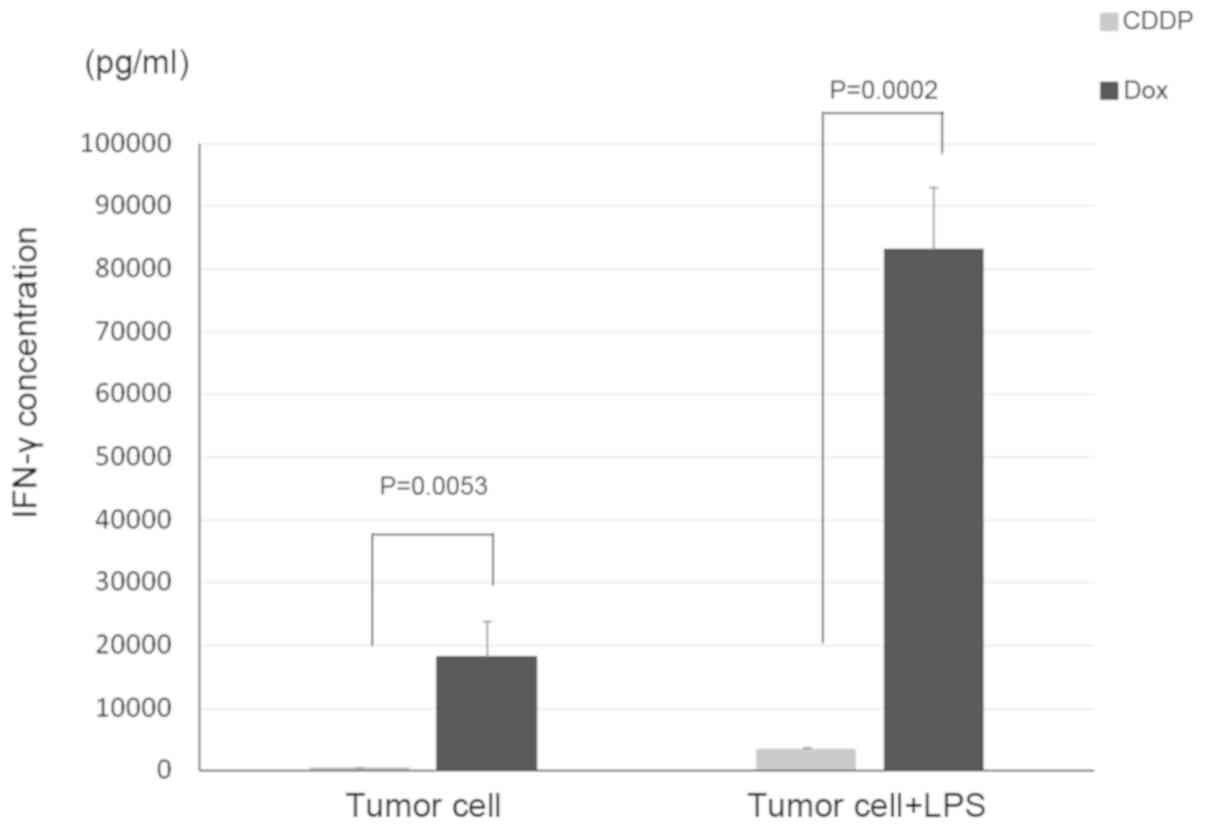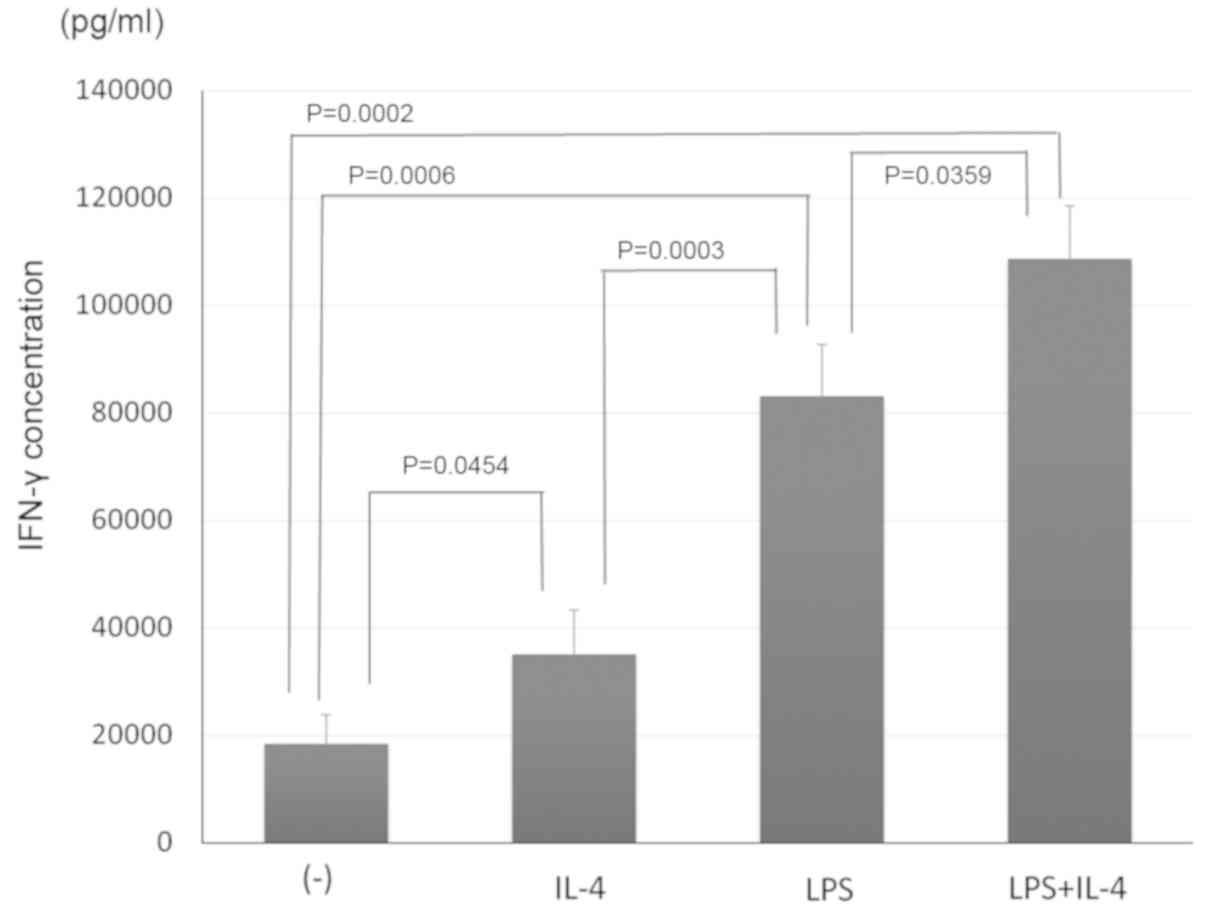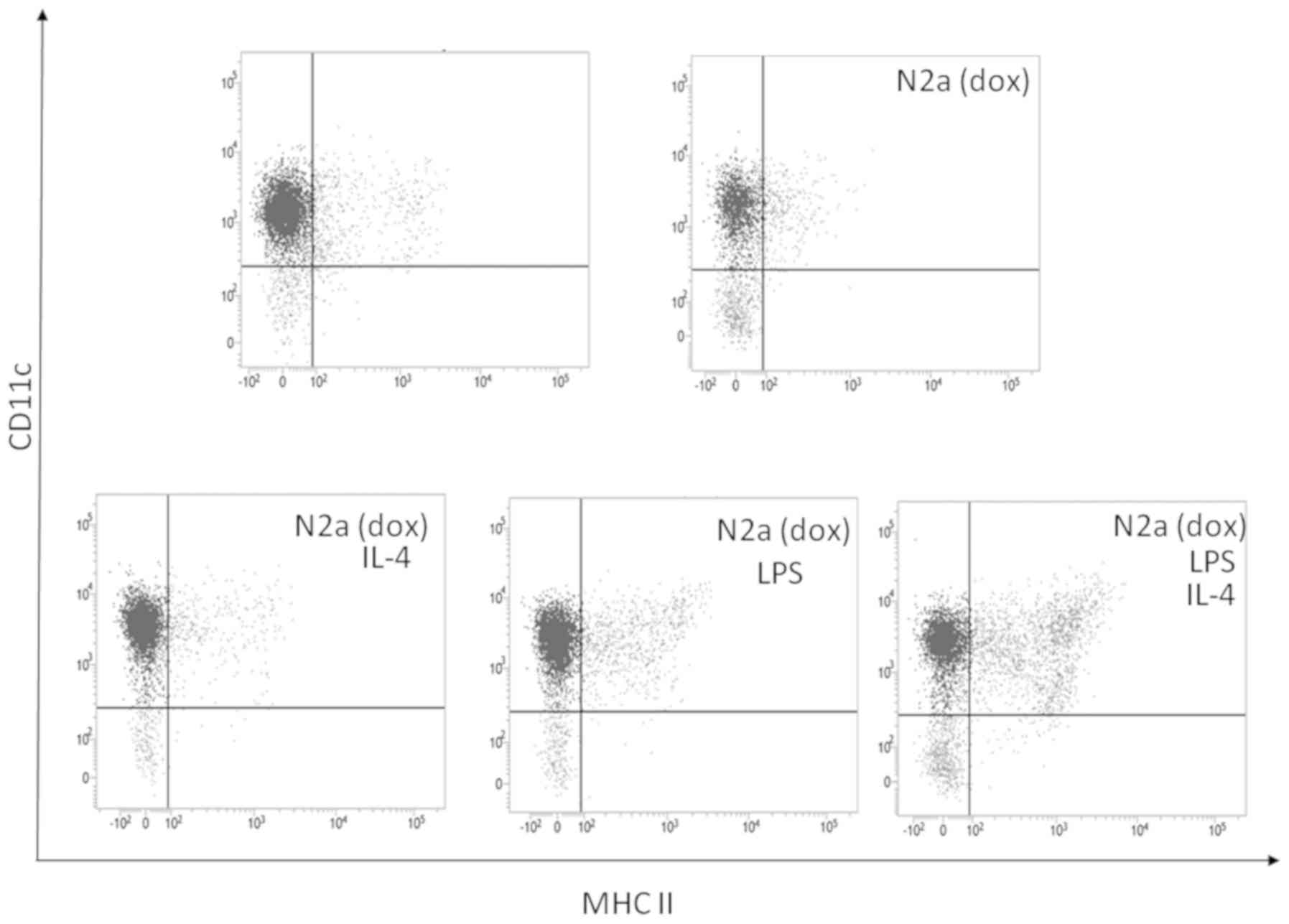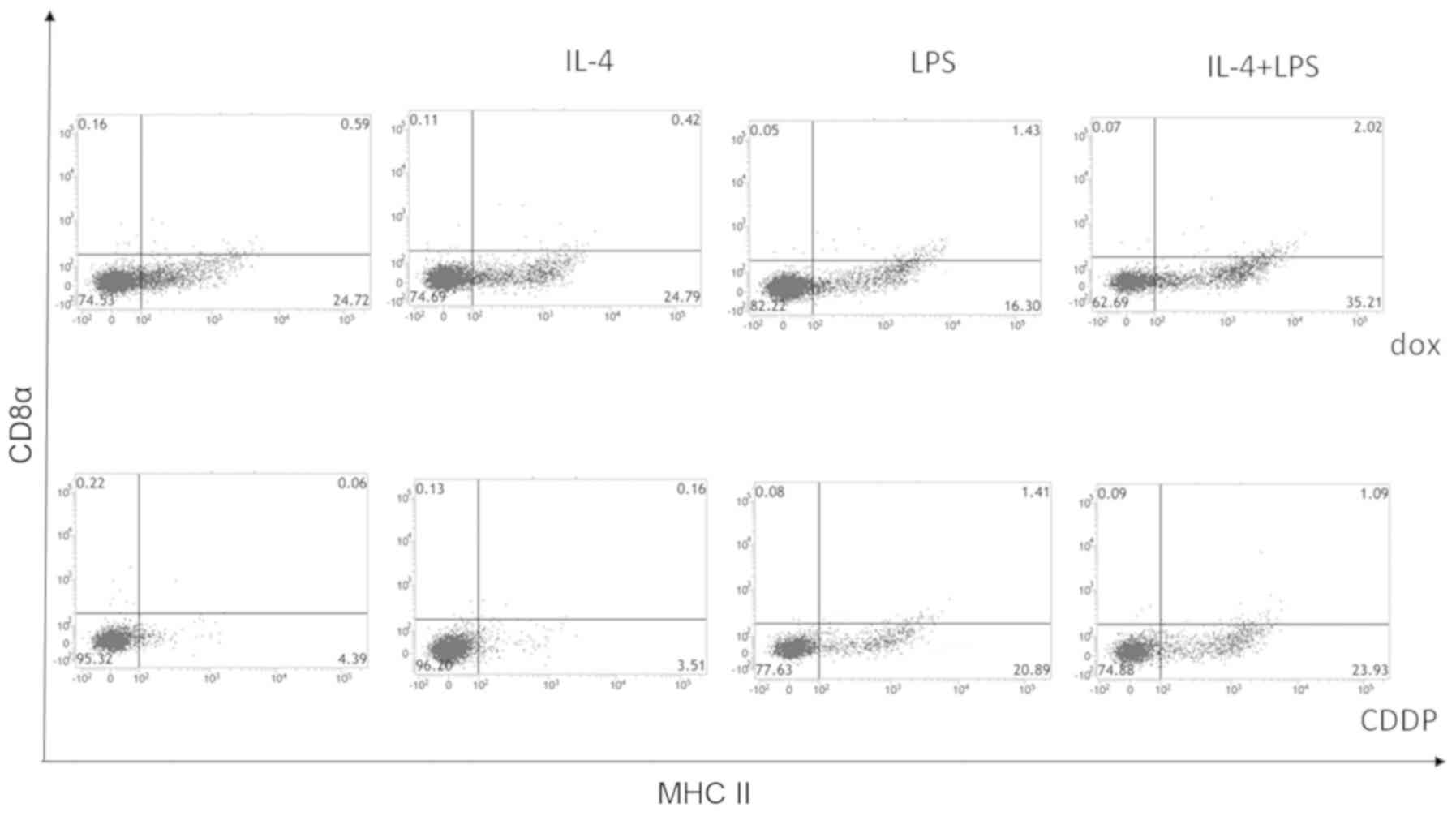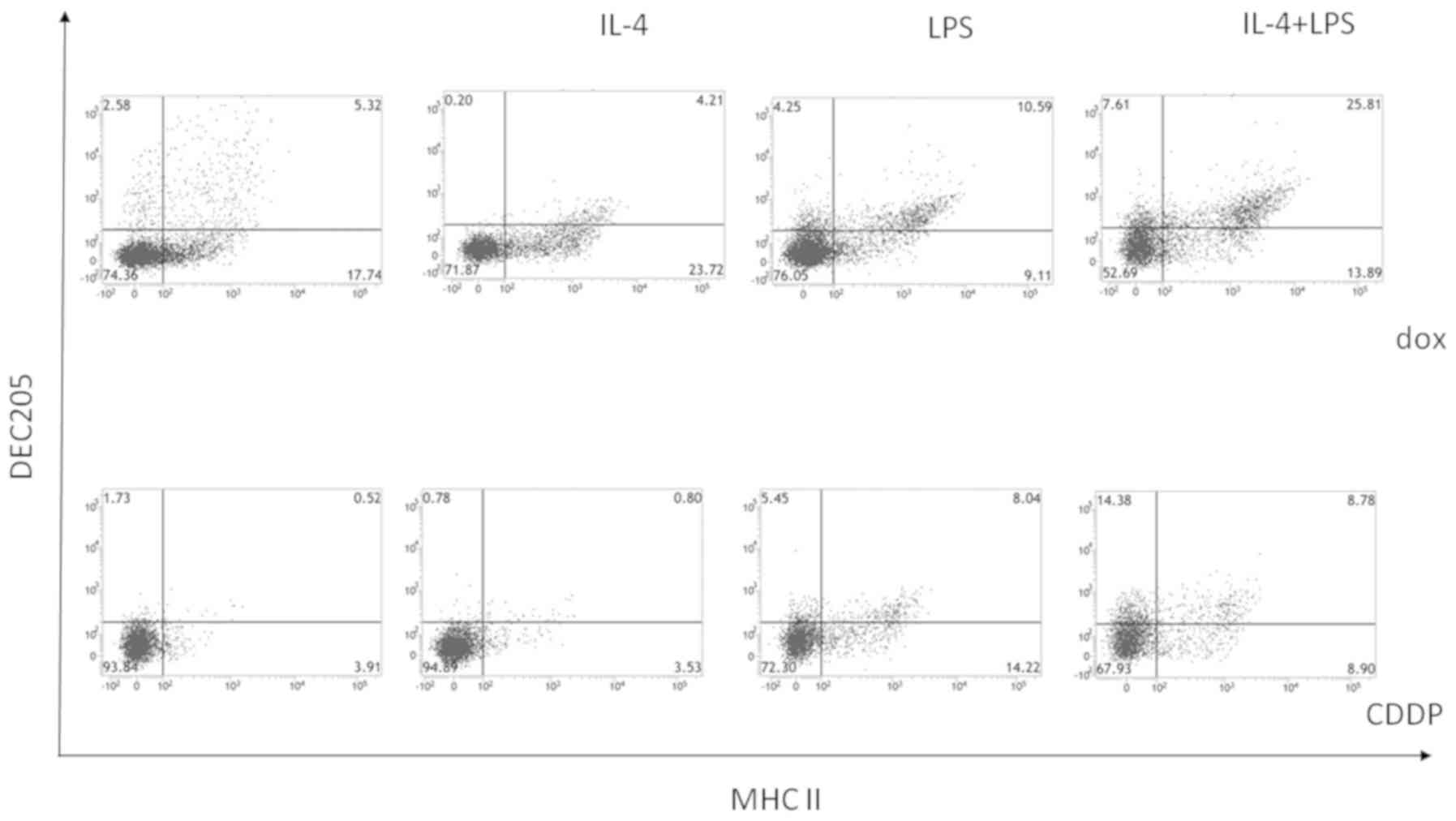Ex vivo induction of antitumor DEC‑205+ CD11c+ cells in a murine neuroblastoma model by co‑stimulation with doxorubicin, lipopolysaccharide and interleukin‑4
Corrigendum in: /10.3892/br.2020.1351
- Authors:
- Published online on: November 20, 2015 https://doi.org/10.3892/br.2015.546
- Pages: 27-32
Abstract
Introduction
In neuroblastoma patients with minimal residual cancer following intensive multimodal therapy (combining surgical resection, radiation and chemotherapy), immunotherapy is considered a promising approach. Passive immunotherapy using antibodies has been performed in high-risk neuroblastoma patients and has led to improvements of the outcome (1,2), indicating that immunological mechanisms can influence the eradication of tumor cells in these patients. Induction of an immune response to residual malignant cells is the key to development of next-generation immunotherapy regimens.
Chemoimmunotherapy focuses on the immunological benefits of chemotherapy agents that influence antitumor immunity via modulation of the host immune system or inducing immunogenicity of tumor cells (3). Combination therapy with multiple antitumor agents induces tumor cell death. Apoptotic tumor cells are usually engulfed by phagocytes, such as macrophages or dendritic cells (DC), and this can subsequently induce an immune response (4). Whether the engulfed apoptotic cells induce immune tolerance or an immunogenic reaction depends on the phagocytes involved (5,6). In addition, a recent study revealed that the mechanism of cell death induced by chemotherapy agents also influences the immunogenicity of dying tumor cells. Our previous study demonstrated that ex vivo treatment with doxorubicin can induce immunogenic tumor cell death in a mouse neuroblastoma model (7). Such findings have provided specific insight into the immunological benefits and drawbacks of conventional antitumor agents.
The present study was performed to investigate the targeting of innate cellular immunity against neuroblastoma. The aim was to induce immunoactive phagocytic cells by co-culture of bone marrow cells with neuroblastoma cells that had been killed by exposure to doxorubicin, and analyze the characteristics of bone marrow-derived cells that induced an immune response to neuroblastoma cells, in order to establish a novel immunotherapy method for high-risk neuroblastoma patients.
Materials and methods
Murine tumor cell line
A mouse neuroblastoma cell line that was developed in A/J mice, neuro-2a (H2-Ka, CCL-131), was purchased from the American Type Culture Collection (ATCC, Manassas, VA, USA). The cells were maintained in minimal essential medium (MEM) with 10% fetal bovine serum (ATCC) and 1% penicillin-streptomycin (10,000 U/ml) (Gibco, Thermo Fisher Scientific, Carlsbad, CA, USA).
Animals
Female A/J mice (H2-Ka) aged 8–12 weeks were purchased from SLC (Hamamatsu, Shizuoka, Japan) and maintained under standard conditions. The Animal Care and Use Committee (Medical Center, Saitama Medical University, Kawagoe, Saitama, Japan) approved the animal procedures.
Induction of tumor cell death
Induction of cell death by doxorubicin (Sigma-Aldrich, St. Louis, MO, USA) or cisplatin (Maruko® cisplatin for I.V. infusion; Yakult, Tokyo, Japan) was performed as reported previously (7). Briefly, neuro-2a cells were plated in 10-cm culture dishes (Corning, One Riverfront Plaza Corning, NY, USA) and cultured in RPMI-1640 medium supplemented with 10% fetal calf serum (FCS), 50 µM 2-mercaptoethanol (2-ME) (Sigma-Aldrich), 1% MEM non-essential amino acid solution, and 1% antibiotics/antimycotic solution (Gibco, Thermo Fisher Scientific), containing 5 µM doxorubicin or 0.025 mg/ml cisplatin for 24 (doxorubicin) or 72 h (cisplatin).
Generation of bone marrow-derived DCs by co-culture with killed neuro-2a cells and adjuvants
Cluster of differentiation (CD) 11c+ major histocompatibility complex (MHC II) II+ cells were harvested as reported previously (7). Briefly, bone marrow cells were harvested from A/J mice and erythrocytes were lysed using erythrocyte lysis solution. Subsequently, the surviving cells were washed and re-suspended in RPMI-1620 medium supplemented with 10% FCS, 50 µM 2-ME (Sigma-Aldrich), 1% MEM with non-essential amino acid and 1% antibiotic/antimycotic solution (Gibco, Thermo Fisher Scientific). Following the addition of 20 ng/ml recombinant mouse granulocyte-macrophage colony stimulating factor (GM-CSF) (R&D Systems, Inc., Minneapolis, MN, USA) to the medium, cells were plated in 10-cm culture dishes and incubated at 37°C under 5% CO2. Fresh medium containing 20 ng/ml GM-CSF was added after 3 days.
On day 7 of culture, doxorubicin-treated neuro-2a cells (2×105/well), with/without interleukin-4 at a final concentration of 1,000 U/ml (Sigma-Aldrich), were added to the dish for stimulation of bone marrow cells and incubation was continued. At 12 h before the cells were harvested, lipopolysaccharide (LPS) was added to the culture at a final concentration of 100 ng/ml. As doxorubicin, but not cisplatin, was previously reported to induce immunogenic death of mouse neuroblastoma cells (7), cisplatin was used as a negative control. The adherent cells were harvested by trypsinization 8 days after starting bone marrow cell culture.
Measurement of in vitro interferon-γ production by co-cultured CD8α+ T cells
Our previous study reported that the interferon-γ concentration in the culture supernatant provides an index of CD8α+ lymphocyte proliferation when CD8α+ lymphocytes are co-cultured with antigen-presenting cells and killed neuro-2a cells (7). The ability of bone marrow-derived adherent cells to induce proliferation of CD8α+ lymphocytes was evaluated. Briefly, CD8α+ cells were harvested from the inguinal and mesenteric lymph nodes and spleens of A/J mice using CD8α magnetic beads (Miltenyi Biotec GmbH, Bergisch Gladbach, Germany), followed by positive selection with an auto MACS Pro (Miltenyi Biotec GmbH). Subsequently, the CD8α+ lymphocytes, bone marrow-derived adherent cells (0.5×105) and neuro-2a cells (2.0×105) were treated overnight with ultraviolet (UV) light and were plated in 24-well flat-bottomed plates coated with hamster anti-mouse CD3/CD28 antibody (BD Biosciences, San Diego, CA, USA) in 1 ml of RPMI-1640 medium supplemented with 10% FCS, 50 µM 2-ME, 1% MEM with non-essential amino acids and 1% antibiotic/antimycotic solution. Subsequently, the concentration of interferon-γ in the culture supernatant was measured with a mouse interferon-γ enzyme-linked immunosorbent assay (ELISA) kit (BD Biosciences) according to the manufacturer's instructions.
Surface antigen analysis of bone marrow-derived DC co-cultured with killed neuro-2a cells
Surface antigens expressed by bone marrow-derived adherent cells were analyzed by flow cytometry (FACS), with the expression of CD11c, MHC class II antigens, CD8α and DEC-205 detected by the phycoerythrin-conjugated anti-mouse CD11c antibody (MCD11C04; Invitrogen), fluorescein isothiocyanate-conjugated anti-MHC class II antibody (130–102–168; Miltenyi Biotec GmbH), and APC-conjugated CD8α and DEC-205 antibodies (110712 and 138206, respectively; Biolegend, San Diego, CA, USA), respectively. Following culture of bone marrow cells for 7 days, and overnight incubation with killed neuro-2a cells with/without LPS and/or interleukin-4, adherent cells were harvested by trypsinization, re-suspended in MACS buffer, and incubated with antibodies for 30 min at 4°C. Subsequent to washing, the cells were re-suspended in MACS running buffer (Miltenyi Biotec GmbH) and surface antigen expression was analyzed using a FACSVerse (BD, Franklin Lakes, NJ, USA).
Results
Induction of an immune response by bone marrow-derived adherent cells co-cultured with doxorubicin-treated neuro-2a cells
To evaluate the induction of CD8α+ lymphocyte proliferation by co-culture with bone-marrow derived adherent cells, interferon-γ production by CD8α+ lymphocytes, UV-treated neuro-2a cells, and bone marrow-derived adherent cells co-cultured with doxorubicin-treated or cisplatin-treated neuro-2a cells was measured. When CD8α+ lymphocytes were incubated with bone marrow-derived adherent cells that had been co-cultured with doxorubicin-treated neuro-2a cells, interferon-γ production was higher when compared with the lymphocytes that were incubated with bone marrow-derived adherent cells, which had been co-cultured with cisplatin-treated neuro-2a cells. Interferon-γ production was significantly enhanced when LPS was added to CD8α+ lymphocytes co-cultured with neuro-2a cells or to bone marrow-derived adherent cells co-cultured with doxorubicin-treated neuro-2a cells (Fig. 1).
Stimulation of bone marrow-derived adherent cells by LPS and interleukin-4 during co-culture promotes acquisition of the ability to induce antitumor immunity
Bone marrow-derived adherent cells were co-cultured with doxorubicin-treated neuro-2a cells plus LPS and/or interleukin-4 to compare their adjuvant effect on the induction of an antitumor immune response by the bone-marrow derived cells. In addition, CD11c+ cells were co-cultured with CD8α+ lymphocytes (as responder cells) and UV-treated neuro-2a cells (as stimulator cells), and the interferon-γ concentration in the supernatant was measured by ELISA as an index of the lymphocyte response. As shown in Fig. 2, interleukin-4 or LPS stimulation of bone marrow-derived adherent cells co-cultured with doxorubicin-treated neuro-2a cells enhanced the lymphocyte response, as revealed by an increased production of interferon-γ. Furthermore, stimulation with interleukin-4 and LPS induced a stronger lymphocyte response from the cultured bone marrow-derived adherent cells.
Stimulation of bone marrow-derived adherent cells with LPS and interleukin-4 promotes induction of CD11c+ MHC class II+ double-positive cells
To confirm the effect of stimulation with interleukin-4 and LPS, FACS analysis of the surface antigen and MHC class II antigen expression by CD11c+ cells was performed. As shown in Fig. 3, LPS stimulation of bone marrow-derived adherent cells co-cultured with doxorubicin-treated neuro-2a cells induced MHC class II expression on the surface of CD11c+ cells, while stimulation with interleukin-4 and LPS induced CD11c+ MHC II+ double-positive cells. Thus, co-culture of bone marrow-derived adherent cells with immunogenically killed neuro-2a cells combined with stimulation by interleukin-4 and LPS induced the maturation of CD11c+ cells expressing MHC class II molecules.
Stimulation by LPS and interleukin-4 during co-culture of bone marrow-derived cells with doxorubicin-treated neuro-2a cells induces DEC-205+ CD11c+ MHC class II+ cells, but not CD8α+ cells
To analyze the characteristics of the cells inducing an immune response to neuro-2a cells, the surface expression of CD8α and DEC-205 by CD11c+ MHC class II+ double-positive cells co-cultured with doxorubicin-treated neuro-2a cells and stimulated by interleukin-4 and LPS was investigated. Cisplatin-treated neuro-2a cells were used as a negative control. As shown in Fig. 4, the percentage of CD8α− CD11c+ MHC II+ cells was higher when adherent cells were co-cultured with doxorubicin-treated neuro-2a cells compared to with cisplatin-treated neuro-2a cells, and this effect was enhanced when co-cultures were stimulated by interleukin-4 and LPS. As shown in Fig. 5, DEC-205+ CD11c+ MHC II+ cells increased when bone marrow-derived CD11c+ cells were co-cultured with doxorubicin-treated neuro-2a cells and stimulated by interleukin-4 and LPS. Accordingly, stimulation by interleukin-4 and LPS during co-culture of bone marrow-derived CD11c+ cells with neuro-2a cells (which had been immunogenically killed by doxorubicin) induced an immune response to neuroblastoma cells by promoting maturation of CD11c+ MHC II+ DEC-205+ cells from bone marrow cells, although CD11c+ MHC II+ CD8α+ cells were not increased.
Discussion
Adoption of intensive multimodal therapy significantly improved the initial survival rate of pediatric cancer patients between 1975 and 1995 (8,9). However, it was recently reported that the overall survival of patients with advanced or high-risk neuroblastoma only showed a slight improvement due to the heterogeneity of this tumor and/or acquisition of resistance to conventional therapy (8,10). In a previous clinical trial, the anti-GD2 antibody showed promise for the treatment of high-risk or advanced neuroblastoma (1,2,11–13). GD2 is an antigen that is normally expressed on the surface of neuronal cells, peripheral nerve fibers and skin melanocytes, as well as being highly expressed by neuroblastoma (12,13). Anti-GD2 antibody therapy for neuroblastoma aims to induce passive antibody-dependent cellular cytotoxicity following apoptosis of tumor cells, and also aims to induce complement-dependent cytotoxicity (12). Generating an immune response to tumor cells is considered to be the ‘key’ to effective immunotherapy for high-risk neuroblastoma.
Previous studies have revealed that specific conventional antitumor agents modify the immune response to certain tumor cells by affecting the host immune system or by modulating tumor cell immunogenicity (3,4). In patients with advanced neuroblastoma, initial tumor regression is usually induced by intensive multimodal treatment that includes chemotherapy (12); however, residual tumor cells are not eradicated by the chemotherapy agents. Combining chemoimmunotherapy with passive induction of an antitumor immune response is considered a promising approach to the treatment of high-risk neuroblastoma. Our previous study reported that doxorubicin, a major chemotherapy agent for neuroblastoma, induces immunogenic death of neuroblastoma cells in a murine model (7). In that model, CD11c+ cells derived from the bone marrow promoted lymphocyte proliferation more effectively compared to CD11b+ spleen cells (7). The present study was performed to investigate the lymphocyte response subsequent to the CD11c+ cells from the bone marrow phagocytosed neuroblastoma cells that had been immunogenically killed by doxorubicin. Cisplatin was used as the negative control as it was revealed that doxorubicin induces immunogenic death of mouse neuroblastoma cells, while cisplatin does not (7). As shown in Figs. 1 and 2, interferon-γ production in co-cultures of CD8α+ lymphocytes (responder cells) with UV-treated neuro-2a cells (stimulator cells) and CD11c+ cells (antigen-presenting effector cells) was promoted when CD11c+ cells and doxorubicin-treated neuro-2a cells were co-cultured with interleukin-4 or LPS prior to harvesting for subsequent co-culture with CD8α+ lymphocytes. Therefore, CD11c+ cells derived from the bone marrow can be ‘educated’ by co-culture with tumor cells that have been immunogenically killed by doxorubicin. In addition, interleukin-4 and/or LPS act as adjuvants to promote the ‘educational’ effect of immunogenically killed neuro-2a cells. Interleukin-4 and LPS showed a stronger adjuvant effect when the two agents were added to cultures simultaneously. During conventional chemotherapy for malignancy, Apetoh et al (14) found that Toll-like receptor 4 stimulation is essential for DC to cross-present antigens from dying tumor cells, leading to induction of antitumor immunity. In addition, interleukin-4 has been reported to expand and activate DC and stimulate antitumor immunity in vivo (15,16). In addition, interleukin-4 was reported to prevent blockade of DC maturation by renal cell carcinoma (17). These immunomodulatory mechanisms may have been involved in the induction of antitumor immunity to neuroblastoma cells in the present study.
To establish effective immunotherapy for advanced neuroblastoma, promoting the presentation of tumor antigens by specific cells involved in innate cellular immune responses is vital for initiation of antitumor immunity.
Tumor cells exhibit poor immunogenicity (18). Our previous study demonstrated that the immunogenicity of neuroblastoma cells could be increased by applying the concepts of chemoimmunotherapy (7). In the present study, the initiation of DC maturation and the promotion of tumor antigen presentation were assessed in order to establish a new immunotherapy method. DEC-205 is a cell surface antigen expressed by DC, B cells and T cells (19), including CD8+ DC. CD8+ DEC-205+ DC are considered to specialize in the uptake of dying cells and presentation of MHC class I antigens. By contrast, CD11c+ CD8− 33D1+ cells were reported to specialize in presenting MHC class II antigens and the initiation of CD4+ T cell responses (20). Neubert et al (21) demonstrated that CD11c+ CD8−33D1+ DC and CD11c+ CD8+ DEC-205+ DC could present tumor antigens and reduce tumor growth, thus prolonging the survival of melanoma-bearing mice. In the present study, CD11c+ MHC II+ DEC-205+ DC increased, while CD8α+ cells did not, when GM-CSF-dependent bone marrow cells were co-cultured with immunogenically killed neuroblastoma cells along with stimulation by LPS and interleukin-4, and these CD11c+ MHC II+ DEC-205+ DC promoted interferon-γ production when co-cultured with CD8α+ lymphocytes. Lahoud et al (22) reported that DEC-205 expressed on DC is a key receptor for binding CpG oligodendronucleotides and has an important role in the production of various cytokines. Thus, not only direct presentation of tumor antigens but also other indirect mechanisms could be involved in promoting the response of CD8α+ lymphocytes when CD11c+ cells were co-cultured with immunogenically killed tumor cells and stimulated by LPS and interleukin-4.
In conclusion, the antigen-presenting cells that were induced from bone marrow cells promoted interferon-γ production in co-cultures of CD8α+ lymphocytes and murine neuroblastoma cells. Induction of these cells was achieved by co-culture with tumor cells (subsequent to causing immunogenic death by exposure to doxorubicin) plus stimulation by LPS and interleukin-4. These cells showed surface expression of CD11c, MHC II and DEC-205. However, CD11c+ MHC II+ CD8α+ cells were not induced by this co-culture system.
Acknowledgements
The present study was supported in part by a Saitama Medical University Internal grant (no. 25B105) and by a Grant-in-Aid for Scientific Research (C) (no. 15K10927).
References
|
Yu AL, Gilman AL, Ozkaynak MF, London WB, Kreissman SG, Chen HX, Smith M, Anderson B, Villablanca JG, Matthay KK, et al: Children's Oncology Group: Anti-GD2 antibody with GM-CSF, interleukin-2, and isotretinoin for neuroblastoma. N Engl J Med. 363:1324–1334. 2010. View Article : Google Scholar : PubMed/NCBI | |
|
Navid F, Sondel PM, Barfield R, Shulkin BL, Kaufman RA, Allay JA, Gan J, Hutson P, Seo S, Kim K, et al: Phase I trial of a novel anti-GD2 monoclonal antibody, Hu14.18K322A, designed to decrease toxicity in children with refractory or recurrent neuroblastoma. J Clin Oncol. 32:1445–1452. 2014. View Article : Google Scholar : PubMed/NCBI | |
|
Chen G and Emens LA: Chemoimmunotherapy: Reengineering tumor immunity. Cancer Immunol Immunother. 62:203–216. 2013. View Article : Google Scholar : PubMed/NCBI | |
|
Emens LA: Chemoimmunotherapy. Cancer J. 16:295–303. 2010. View Article : Google Scholar : PubMed/NCBI | |
|
Ullrich E, Ménard C, Flament C, Terme M, Mignot G, Bonmort M, Plumas J, Chaperot L, Chaput N and Zitvogel L: Dendritic cells and innate defense against tumor cells. Cytokine Growth Factor Rev. 19:79–92. 2008. View Article : Google Scholar : PubMed/NCBI | |
|
Sica A: Role of tumour-associated macrophages in cancer-related inflammation. Exp Oncol. 32:153–158. 2010.PubMed/NCBI | |
|
Inoue S, Setoyama Y and Odaka A: Doxorubicin treatment induces tumor cell death followed by immunomodulation in a murine neuroblastoma model. Exp Ther Med. 7:703–708. 2014.PubMed/NCBI | |
|
Maris JM: Recent advances in neuroblastoma. N Engl J Med. 362:2202–2211. 2010. View Article : Google Scholar : PubMed/NCBI | |
|
Smith MA, Altekruse SF, Adamson PC, Reaman GH and Seibel NL: Declining childhood and adolescent cancer mortality. Cancer. 120:2497–2506. 2014. View Article : Google Scholar : PubMed/NCBI | |
|
Maris JM, Hogarty MD, Bagatell R and Cohn SL: Neuroblastoma. Lancet. 369:2106–2120. 2007. View Article : Google Scholar : PubMed/NCBI | |
|
Hara J: Development of treatment strategies for advanced neuroblastoma. Int J Clin Oncol. 17:196–203. 2012. View Article : Google Scholar : PubMed/NCBI | |
|
Parsons K, Bernhardt B and Strickland B: Targeted immunotherapy for high-risk neuroblastoma - the role of monoclonal antibodies. Ann Pharmacother. 47:210–218. 2013. View Article : Google Scholar : PubMed/NCBI | |
|
Mackall CL, Merchant MS and Fry TJ: Immune-based therapies for childhood cancer. Nat Rev Clin Oncol. 11:693–703. 2014. View Article : Google Scholar : PubMed/NCBI | |
|
Apetoh L, Ghiringhelli F, Tesniere A, Obeid M, Ortiz C, Criollo A, Mignot G, Maiuri MC, Ullrich E, Saulnier P, et al: Toll-like receptor 4-dependent contribution of the immune system to anticancer chemotherapy and radiotherapy. Nat Med. 13:1050–1059. 2007. View Article : Google Scholar : PubMed/NCBI | |
|
Roth MD, Gitlitz BJ, Kiertscher SM, Park AN, Mendenhall M, Moldawer N and Figlin RA: Granulocyte macrophage colony-stimulating factor and interleukin 4 enhance the number and antigen-presenting activity of circulating CD14+ and CD83+ cells in cancer patients. Cancer Res. 60:1934–1941. 2000.PubMed/NCBI | |
|
Kiertscher SM, Gitlitz BJ, Figlin RA and Roth MD: Granulocyte/macrophage-colony stimulating factor and interleukin-4 expand and activate type-1 dendritic cells (DC1) when administered in vivo to cancer patients. Int J Cancer. 107:256–261. 2003. View Article : Google Scholar : PubMed/NCBI | |
|
Menetrier-Caux C, Thomachot MC, Alberti L, Montmain G and Blay JY: IL-4 prevents the blockade of dendritic cell differentiation induced by tumor cells. Cancer Res. 61:3096–3104. 2001.PubMed/NCBI | |
|
Ashman LK: The immunogenicity of tumour cells. Immunol Cell Biol. 65:271–277. 1987. View Article : Google Scholar : PubMed/NCBI | |
|
Inaba K, Swiggard WJ, Inaba M, Meltzer J, Mirza A, Sasagawa T, Nussenzweig MC and Steinman RM: Tissue distribution of the DEC-205 protein that is detected by the monoclonal antibody NLDC-145. I. Expression on dendritic cells and other subsets of mouse leukocytes. Cell Immunol. 163:148–156. 1995. View Article : Google Scholar : PubMed/NCBI | |
|
Dudziak D, Kamphorst AO, Heidkamp GF, Buchholz VR, Trumpfheller C, Yamazaki S, Cheong C, Liu K, Lee HW, Park CG, et al: Differential antigen processing by dendritic cell subsets in vivo. Science. 315:107–111. 2007. View Article : Google Scholar : PubMed/NCBI | |
|
Neubert K, Lehmann CH, Heger L, Baranska A, Staedtler AM, Buchholz VR, Yamazaki S, Heidkamp GF, Eissing N, Zebroski H, et al: Antigen delivery to CD11c+CD8− dendritic cells induces protective immune responses against experimental melanoma in mice in vivo. J Immunol. 192:5830–5838. 2014. View Article : Google Scholar : PubMed/NCBI | |
|
Lahoud MH, Ahmet F, Zhang JG, Meuter S, Policheni AN, Kitsoulis S, Lee CN, O'Keeffe M, Sullivan LC, Brooks AG, et al: DEC-205 is a cell surface receptor for CpG oligonucleotides. Proc Natl Acad Sci USA. 109:16270–16275. 2012. View Article : Google Scholar : PubMed/NCBI |



